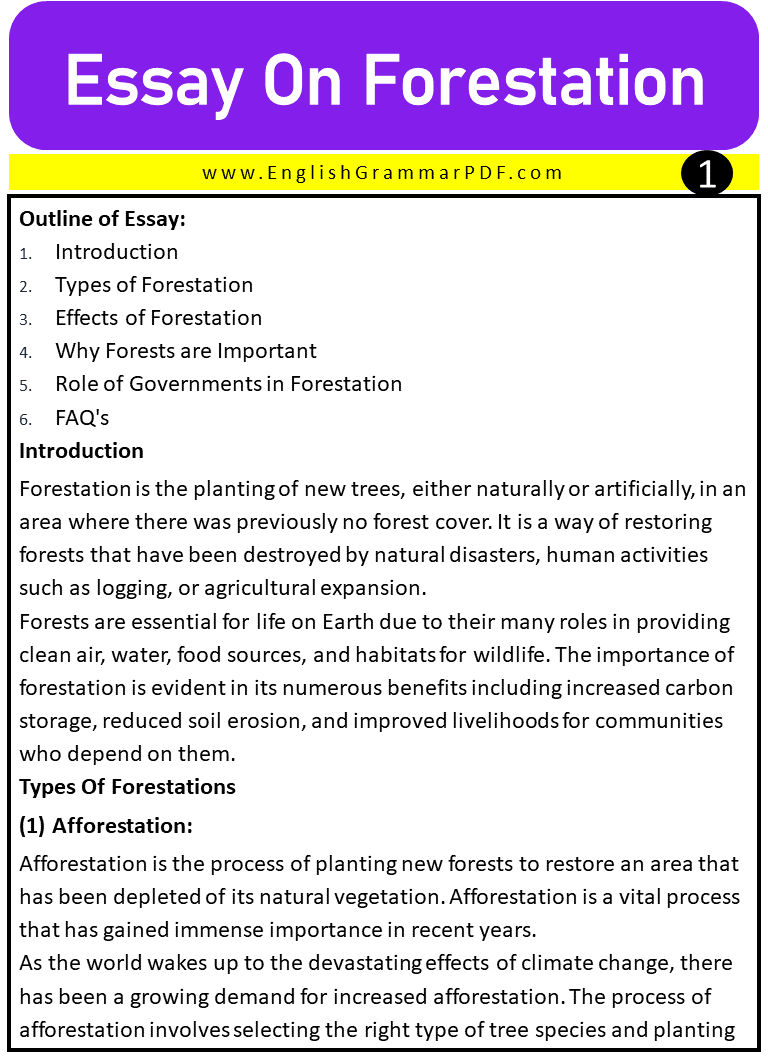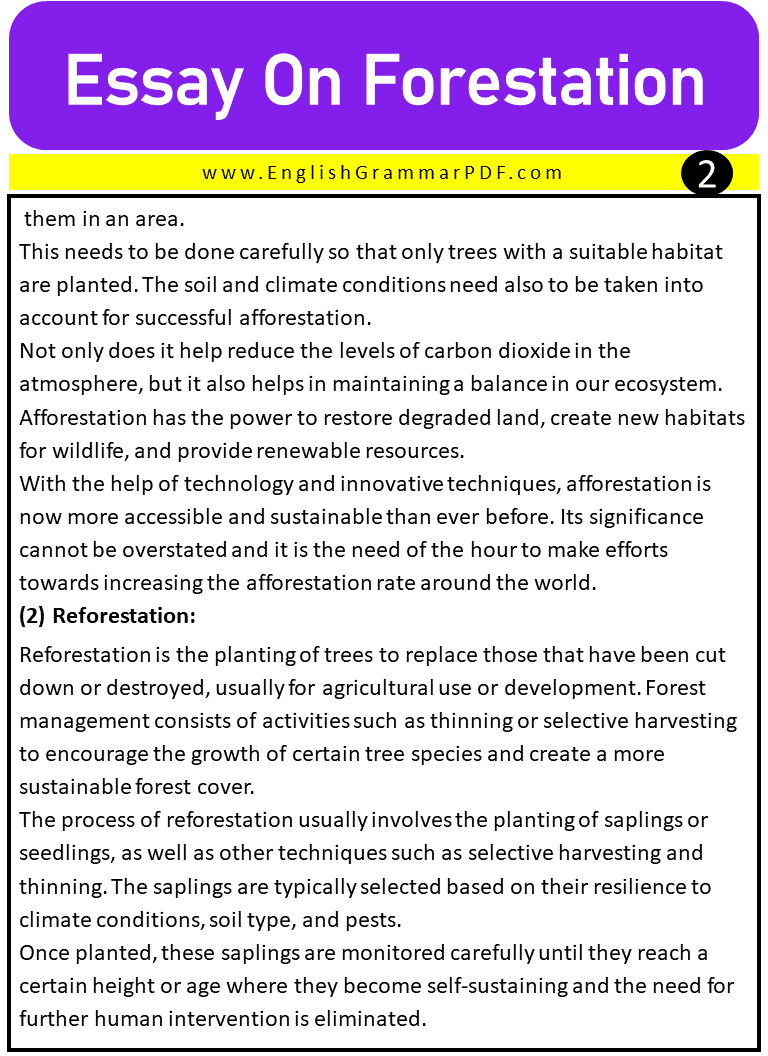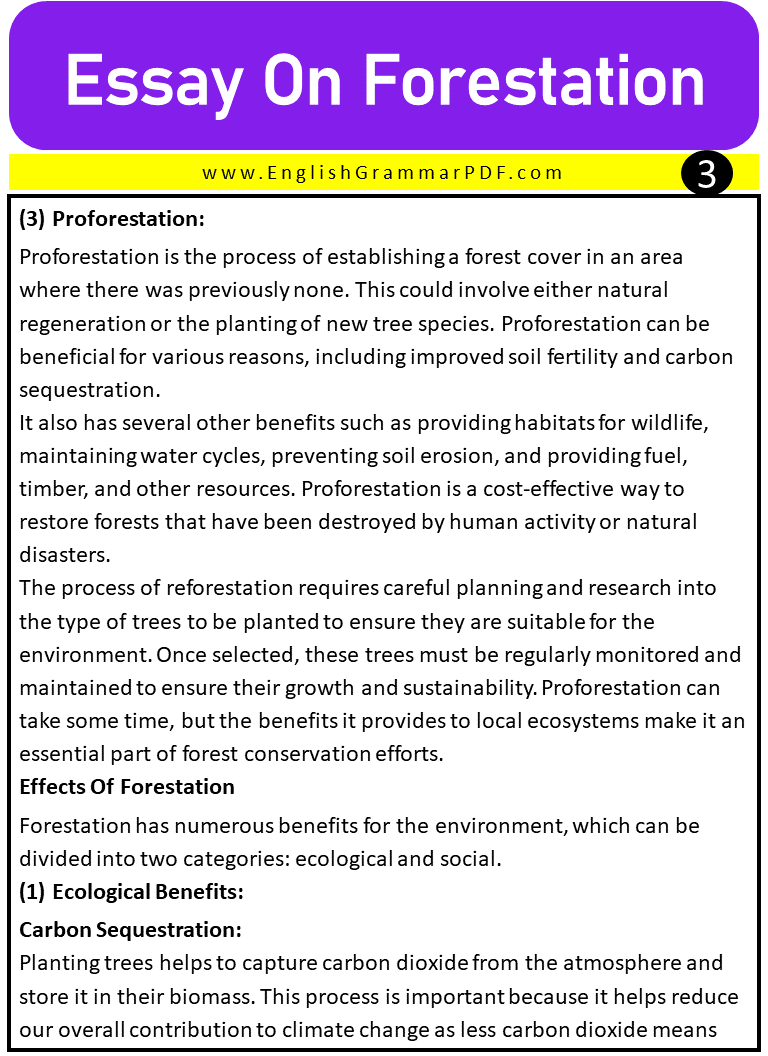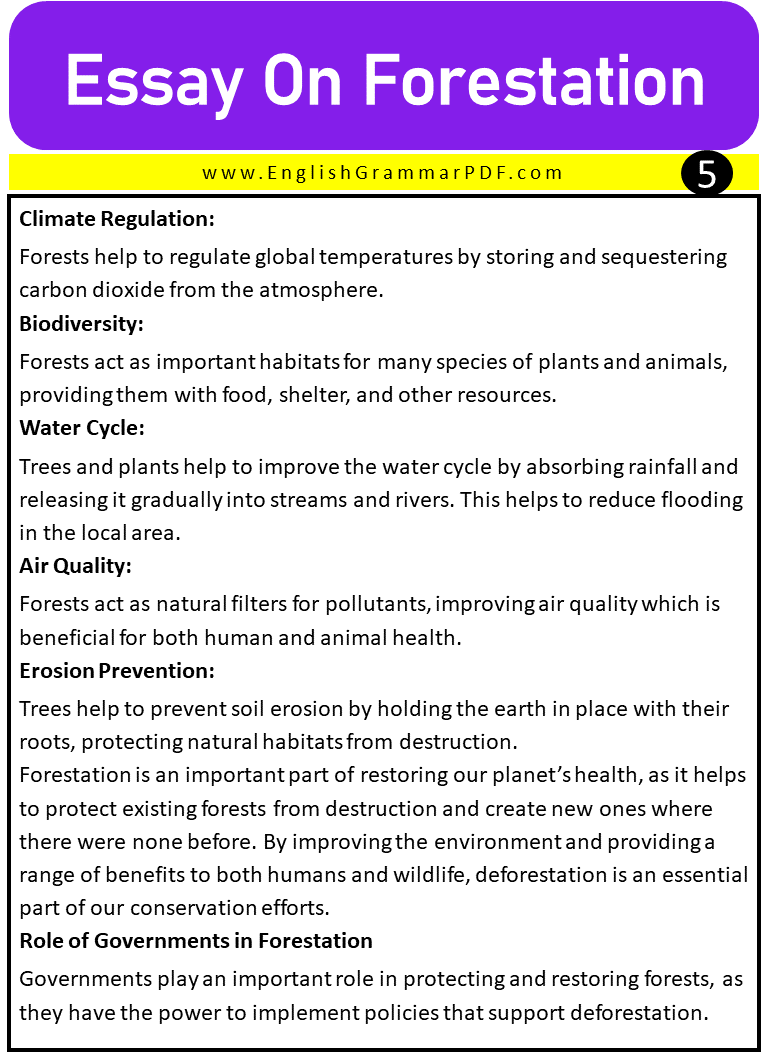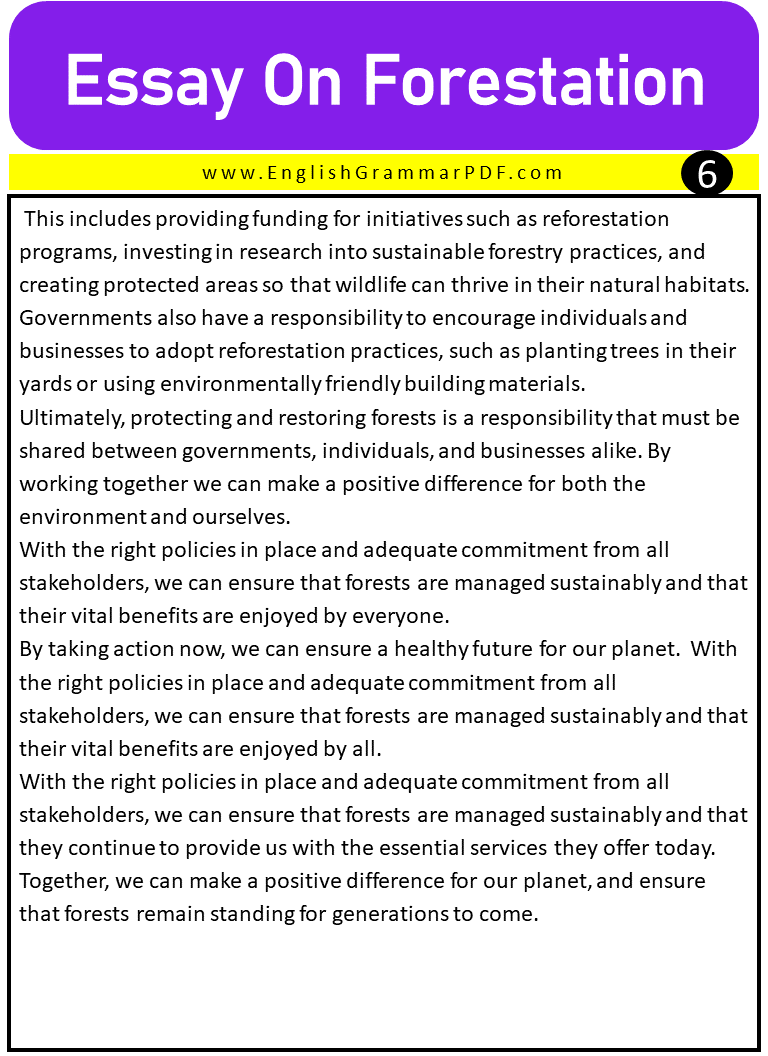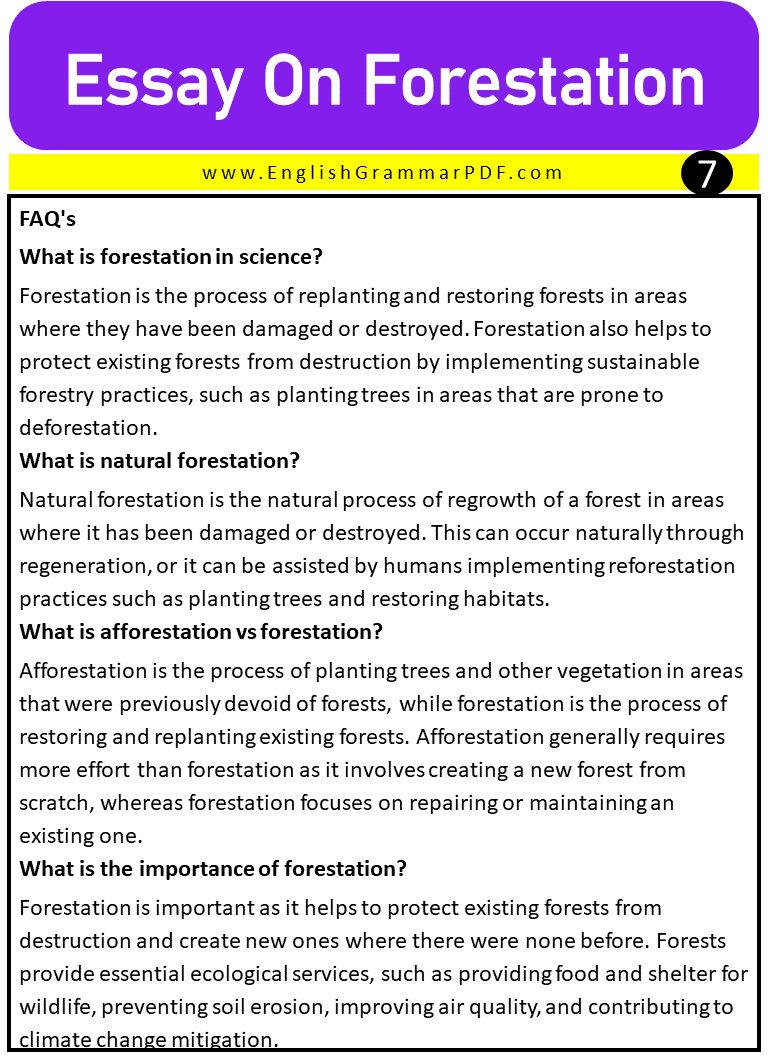Essay On Forestation
Outline of Essay:
- Introduction
- Types of Forestation
- Effects of Forestation
- Why Forests are Important
- Role of Governments in Forestation
- FAQ’s

Discover More:
Introduction
Forestation is the planting of new trees, either naturally or artificially, in an area where there was previously no forest cover. It is a way of restoring forests that have been destroyed by natural disasters, human activities such as logging, or agricultural expansion.
Forests are essential for life on Earth due to their many roles in providing clean air, water, food sources, and habitats for wildlife. The importance of forestation is evident in its numerous benefits including increased carbon storage, reduced soil erosion, and improved livelihoods for communities who depend on them.
Types Of Forestations
(1) Afforestation:
Afforestation is the process of planting new forests to restore an area that has been depleted of its natural vegetation. Afforestation is a vital process that has gained immense importance in recent years.
As the world wakes up to the devastating effects of climate change, there has been a growing demand for increased afforestation. The process of afforestation involves selecting the right type of tree species and planting them in an area.
This needs to be done carefully so that only trees with a suitable habitat are planted. The soil and climate conditions need also to be taken into account for successful afforestation.
Not only does it help reduce the levels of carbon dioxide in the atmosphere, but it also helps in maintaining a balance in our ecosystem. Afforestation has the power to restore degraded land, create new habitats for wildlife, and provide renewable resources.
With the help of technology and innovative techniques, afforestation is now more accessible and sustainable than ever before. Its significance cannot be overstated and it is the need of the hour to make efforts towards increasing the afforestation rate around the world.
(2) Reforestation:
Reforestation is the planting of trees to replace those that have been cut down or destroyed, usually for agricultural use or development. Forest management consists of activities such as thinning or selective harvesting to encourage the growth of certain tree species and create a more sustainable forest cover.
The process of reforestation usually involves the planting of saplings or seedlings, as well as other techniques such as selective harvesting and thinning. The saplings are typically selected based on their resilience to climate conditions, soil type, and pests.
Once planted, these saplings are monitored carefully until they reach a certain height or age where they become self-sustaining and the need for further human intervention is eliminated.
(3) Proforestation:
Proforestation is the process of establishing a forest cover in an area where there was previously none. This could involve either natural regeneration or the planting of new tree species. Proforestation can be beneficial for various reasons, including improved soil fertility and carbon sequestration.
It also has several other benefits such as providing habitats for wildlife, maintaining water cycles, preventing soil erosion, and providing fuel, timber, and other resources. Proforestation is a cost-effective way to restore forests that have been destroyed by human activity or natural disasters.
The process of reforestation requires careful planning and research into the type of trees to be planted to ensure they are suitable for the environment. Once selected, these trees must be regularly monitored and maintained to ensure their growth and sustainability. Proforestation can take some time, but the benefits it provides to local ecosystems make it an essential part of forest conservation efforts.
Effects Of Forestation
Forestation has numerous benefits for the environment, which can be divided into two categories: ecological and social.
(1) Ecological Benefits:
Carbon Sequestration:
Planting trees helps to capture carbon dioxide from the atmosphere and store it in their biomass. This process is important because it helps reduce our overall contribution to climate change as less carbon dioxide means fewer greenhouse gas emissions.
Improved Soil Quality:
Trees help to prevent soil erosion and improve its quality by reducing the impact of raindrops. This helps to maintain soil fertility, which in turn helps promote biodiversity.
Water Purification:
Forests act as natural filters for water, removing sediment and pollutants from runoff into streams and rivers. This is important for both human and animal life, as it ensures clean drinking water.
(2) Social Benefits:
Livelihoods:
Forests provide a source of income through the sale of timber, resin, honey, and other forest products. This helps to create jobs in rural communities and reduce poverty levels.
Energy Supply:
In many parts of the world, forests provide a source of fuel for cooking and heating. This is especially important in regions where access to electricity is limited.
Cultural Heritage:
Forests often serve as cultural landmarks or places of spiritual significance, providing value beyond their ecological benefits.
Why Forests are Important
Forests are essential for the health of our planet. They provide a range of vital services, including:
1- Climate Regulation:
Forests help to regulate global temperatures by storing and sequestering carbon dioxide from the atmosphere.
2- Biodiversity:
Forests act as important habitats for many species of plants and animals, providing them with food, shelter, and other resources.
3- Water Cycle:
Trees and plants help to improve the water cycle by absorbing rainfall and releasing it gradually into streams and rivers. This helps to reduce flooding in the local area.
4- Air Quality:
Forests act as natural filters for pollutants, improving air quality which is beneficial for both human and animal health.
5- Erosion Prevention:
Trees help to prevent soil erosion by holding the earth in place with their roots, protecting natural habitats from destruction.
Forestation is an important part of restoring our planet’s health, as it helps to protect existing forests from destruction and create new ones where there were none before. By improving the environment and providing a range of benefits to both humans and wildlife, deforestation is an essential part of our conservation efforts.
Role of Governments in Forestation
Governments play an important role in protecting and restoring forests, as they have the power to implement policies that support deforestation. This includes providing funding for initiatives such as reforestation programs, investing in research into sustainable forestry practices, and creating protected areas so that wildlife can thrive in their natural habitats. Governments also have a responsibility to encourage individuals and businesses to adopt reforestation practices, such as planting trees in their yards or using environmentally friendly building materials.
Ultimately, protecting and restoring forests is a responsibility that must be shared between governments, individuals, and businesses alike. By working together we can make a positive difference for both the environment and ourselves.
With the right policies in place and adequate commitment from all stakeholders, we can ensure that forests are managed sustainably and that their vital benefits are enjoyed by everyone.
By taking action now, we can ensure a healthy future for our planet. With the right policies in place and adequate commitment from all stakeholders, we can ensure that forests are managed sustainably and that their vital benefits are enjoyed by all.
With the right policies in place and adequate commitment from all stakeholders, we can ensure that forests are managed sustainably and that they continue to provide us with the essential services they offer today. Together, we can make a positive difference for our planet, and ensure that forests remain standing for generations to come.
FAQ’s
What is forestation in science?
Forestation is the process of replanting and restoring forests in areas where they have been damaged or destroyed. Forestation also helps to protect existing forests from destruction by implementing sustainable forestry practices, such as planting trees in areas that are prone to deforestation.
What is natural forestation?
Natural forestation is the natural process of regrowth of a forest in areas where it has been damaged or destroyed. This can occur naturally through regeneration, or it can be assisted by humans implementing reforestation practices such as planting trees and restoring habitats.
What is afforestation vs forestation?
Afforestation is the process of planting trees and other vegetation in areas that were previously devoid of forests, while forestation is the process of restoring and replanting existing forests. Afforestation generally requires more effort than forestation as it involves creating a new forest from scratch, whereas forestation focuses on repairing or maintaining an existing one.
What is the importance of forestation?
Forestation is important as it helps to protect existing forests from destruction and create new ones where there were none before. Forests provide essential ecological services, such as providing food and shelter for wildlife, preventing soil erosion, improving air quality, and contributing to climate change mitigation.
Download PDF of Essay On Forestation
